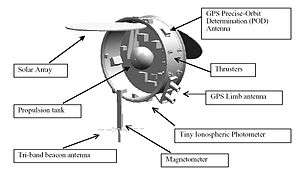Constellation Observing System for Meteorology, Ionosphere, and Climate
_logo.png) COSMIC | |
| Names | Formosat 3 |
|---|---|
| Mission type | Meteorology, Ionosphere, Climatology, and Space weather research |
| COSPAR ID | 2006-011A through 2006-011F |
| SATCAT no. | 29047 through 29052 |
| Website | COSMIC at UCAR |
| Spacecraft properties | |
| Manufacturer | Orbital Sciences Corporation |
| Launch mass | 155 lb (70 kg) |
| Start of mission | |
| Launch date | 01:40, April 15, 2006--> |
| Rocket | Minotaur |
| Orbital parameters | |
| Reference system | Geocentric |
| Eccentricity | 0 |
| Perigee | 500 km (310 mi) |
| Apogee | 500 km (310 mi) |
| Inclination | 72° |
Constellation Observing System for Meteorology, Ionosphere, and Climate (COSMIC) is a program designed to provide advances in meteorology, ionospheric research, climatology, and space weather by using GPS satellites in conjunction with low Earth orbiting (LEO) satellites. The term "COSMIC" may refer to either the organization itself or the constellation of satellites (also known as FORMOSAT-3, 福爾摩沙衛星三號, in Taiwan). The constellation is a joint U.S.-Taiwanese project with major participants including the University Corporation for Atmospheric Research (UCAR), the National Science Foundation, the Naval Research Laboratory (NRL), the Air Force Research Laboratory (AFRL) on the U.S. side and the National Space Organization (NSPO) on the Taiwanese side.
The total cost of the project is US$100 million, 80% of which is being provided by NSPO, and the remainder by various U.S. agencies.[1]
After experiencing several delays, the launch of the COSMIC satellite constellation atop a Minotaur launch vehicle from Vandenberg AFB occurred at 01:40 GMT, on April 15, 2006, despite heavy fog.[2] The satellites, which orbit at an altitude of 500 miles, required over a year to move into the correct positions to provide full global coverage.
Instruments

The COSMIC satellites are equipped with three primary forms of instrumentation for remote sensing, including:
- GPS Radio Occultation Experiment
- Tri-band beacon (TBB)
- Tiny Ionospheric Photometer (TIP)[3]
Deployment
All 6 microsatellites were launched on a single launch vehicle and deployed into a single parking orbit after launch. The spacecraft were then deployed into separate orbital planes through the use of precession due to the oblateness of the Earth and raised to a final orbital altitude over the course of several months. Scientific data were collected during the deployment process, along with experimental validation and calibration.
Status
Currently only four of the microsatellites remain fully functional. The FM2's power system lost 50% of its output in February 2007, while FM3's solar panel also malfunctioned since August 2007. As a result, both satellites are operating in a degraded state, capable of returning data only during specific solar angles. The FM6 went out of control in September 2007, but control was restored by November 16 of the same year.[4][5] FM3 had severe power problem since July 6, 2010. It is declared not functional since then. FM4, FM5, and FM6 have had battery aging problem.[6]
Orbital information
Parking orbit
- Altitude: 500 km
- Inclination: 72 degrees
- Eccentricity: 0
Final orbital configuration
- Altitude: 700 – 800 km
- Inclination: 72 degrees
- Eccentricity: 0
- Spacing between right ascension of ascending node: 24 degrees
- Spacing in mean anomaly between adjacent orbital planes: 45 degrees
See also
- National Space Organization
- 2006 in spaceflight
- FORMOSAT-7/COSMIC-2, planned replacement mission
- CHAMP
- Gravity Recovery and Climate Experiment (GRACE)
- MetOp, a European weather satellite that also carries a GPS radio occultation receiver
References
- ↑ "COSMIC: About". UCAR COSMIC. Retrieved 2006-04-18.
- ↑ Ray, Justin (2006-04-14). "Launch Coverage for Minotaur Rocket' COSMIC Mission". Spaceflight Now. Archived from the original on 2006-04-15.
- ↑ "New Satellite System Will Use GPS Signals To Track Hurricanes, Climate Change, and Space Weather" (Press release). UCAR. 2006-04-12.
- ↑ COSMIC Current Status Archived 2008-07-04 at the Wayback Machine.
- ↑ COSMIC Homepage
- ↑ C.-J. Fong, D. Whiteley, E. Yang, K. Cook, V. Chu, B. Schreiner, D. Ector, P. Wilczynski, T.-Y. Liu, & N. L. Yen, "Space & Ground Segment Performance of the FORMOSAT-3 / COSMIC Mission: Four Years in Orbit," Atmospheric Measurement Techniques Discussions, Volume 4, Issue 1, 2011, pp. 599-638 (abstract here: http://adsabs.harvard.edu/abs/2011AMTD....4..599F )
External links
| Wikimedia Commons has media related to FORMOSAT-3. |
- Official site
- COSMIC Mission Profile by NASA's Solar System Exploration
- University Corporation for Atmospheric Research (UCAR)
- UCAR Office of Programs (UOP)
- National SPace Organization (NSPO) - COSMIC's Taiwanese counterpart.
- ScienceNOW: The Little Satellite Fleet That Could,
- Journal of Geophysical Research: Space Physics (1978–2012)
- Space Weather and the Global Positioning System